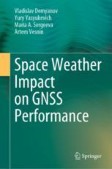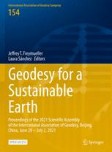Search
Search Results
-
Statistical study of medium-scale traveling ionospheric disturbances in low-latitude ionosphere using an automatic algorithm
This study investigates the medium-scale traveling ionospheric disturbances (MSTIDs) statistically at the low-latitude equatorial ionization anomaly...

-
Automated power spectrum analysis of low-latitude ionospheric scintillations recorded using software GNSS receiver
The impact of equatorial plasma bubbles (EPBs) on signals from navigation satellites has remained unpredictable. EPBs could be tracked to some extent...

-
Measuring phase scintillation at different frequencies with conventional GNSS receivers operating at 1 Hz
Ionospheric scintillation causes rapid fluctuations of measurements from Global Navigation Satellite Systems (GNSSs), thus threatening space-based...

-
Contribution of the Chinese Meridian Project to space environment research: Highlights and perspectives
The Chinese Meridian Project (CMP) is devoted to establishing a comprehensive ground-based monitoring network for China’s space weather research. CMP...
-
A case study of correspondence between Pc1 activity and ionospheric irregularities at polar latitudes
A possible driver of precipitation of magnetospheric energetic electrons in the high-latitude atmosphere is represented by electromagnetic...

-

-
Influence of Different Ionospheric Disturbances on the GPS Scintillations at High Latitudes
In this work we compare the influence of auroral particle precipitation and polar cap patches (PCP) on scintillations of the GPS signals in the polar...
-
Effect of Ionosphere Scintillations on the Loss of Lock-In GPS Signals at Antarctica Region
We studied the effect of amplitude and phase scintillations on the loss of lock during five most disturbed days of the December 2006. During all the...
-
New aspects of the upper atmospheric disturbances caused by the explosive eruption of the 2022 Hunga Tonga–Hunga Ha’apai volcano
The Hunga Tonga–Hunga Ha’apai (HTHH) undersea volcanic eruption that occurred at 04:15 UT on 15 January 2022 is one of the most explosive events in...

-
Classification of the equatorial plasma bubbles using convolutional neural network and support vector machine techniques
Equatorial plasma bubble (EPB) is a phenomenon characterized by depletions in ionospheric plasma density being formed during post-sunset hours. The...

-
GRIMS: global and regional ionosphere monitoring system
The ionosphere shows regular changes such as daily, 27 days, seasonal, semi-annual, annual, and 11 years. These changes can be modeled and their...

-
Prediction of TEC and Range Error using Low-latitude GPS Data during January to April 2022 Solar Flare Events
AbstractThe effects of solar, geomagnetic, and ionospheric anomalies on satellite communication are inextricable. Range Error (RE) is the most common...

-
Features of Using Survey Receivers for Real-time Ionosphere Monitoring
AbstractThe features of using survey GNSS receivers for real-time ionosphere monitoring based on high orbital ionosphere tomography network are...

-
Real-Time Data Assimilation for Space Weather Effects Mitigation on GNSS/SBAS
Ionospheric variability falls into various scales. It has diurnal, seasonal, annual and slower trends. Ionospheric models account for the variability...
-
Experimental Results of GNSS/SBAS Performance Under Space Weather Impacts
GNSS performance is examined under both extreme and dangerous solar radio bursts and strong magnetic storms during the period from 2001 till 2020....
-
Satellite orbit determination and time synchronization using GPS single-frequency observables in low and high solar activities
We assess the orbit accuracy and time synchronization error using the L1 and C1 observables during the different solar activities. In general, GPS...

-
Optimal TEC Forecast Models Based on Machine Learning and Time Series Analysis Techniques: A Preliminary Study on the Ring of Fire
Geomagnetic storms are one of the major factors causing Total Electron Content (TEC) anomalies. Analyses of TEC fluctuations also provide a valuable...
-
Machine learning-based detection of TEC signatures related to earthquakes and tsunamis: the 2015 Illapel case study
Earthquakes and tsunamis can trigger acoustic and gravity waves that could reach the ionosphere, generating electron density disturbances, known as...

-
Effects of storm-induced equatorial plasma bubbles on GPS-based kinematic positioning at equatorial and middle latitudes during the September 7–8, 2017, geomagnetic storm
Space weather can impact significantly on the regular equatorial plasma bubbles (EPB) occurrence. During the severe geomagnetic storm on September...

-
Ordinary kriging - and cokriging - based surrogate model for ionospheric TEC prediction using NavIC/GPS data
The ionospheric total electron content (TEC) plays a major role in the estimation of positional accuracy of satellite-based navigation systems. TEC...

